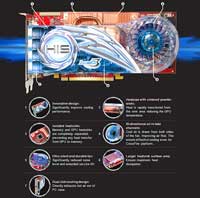A Closer Look At The HIS Radeon X1950 XT IceQ3
Unlike the Radeon X1950 Pro, the X1950 XT does not utilize the RV570 GPU. Instead it uses the same R580+ GPU seen in ATI's flagship Radeon X1950 XTX product. The Radeon X1950 XT is very similar to the XTX, differing only in clock speed and memory. The XT uses 256MB of GDDR3 clocked at 900MHz (1.8GHz effective) while the XTX runs 512MB of GDDR4 modules at 1GHz (2GHz effective). The XT is also a bit slower than the XTX when it comes to core clock, lagging behind the XTX's 650 MHz by 25 MHz. All told, the XT is a slightly slower XTX with half the memory. However, the XTX's hefty $400 price tag is thankfully missing from the XT, which comes in between $250 and $300. This puts the X1950 XT in direct competition with the GeForce 7900GT and 7950GT.
|
|
|
Besides the familiar red PCB, the HIS X1950 XT IceQ3 Turbo looks nothing like an ATI built reference X1950 XT. However, if you take away the fancy IceQ3 cooling apparatus, your left with basically an exact copy of the reference design. Readers of our HIS Radeon X1950 Pro IceQ3 Turbo review will notice that the X1950 XT IceQ3 looks identical. Some readers may also notice that the X1950 XT also looks identical to the HIS Radeon X1900 XT we reviewed earlier this year. They all share the same IceQ3 cooling apparatus and red PCB.
Something to consider in regard to the HIS Radeon X1950 XT IceQ3 Turbo is that while it is CrossFire compatible, pairing it with an X1950 XTX Master Card results in half of the Master Card's memory being disabled; something we can't recommend. Two of these cards can be paired together in a cable-less CrossFire mode as well, but performance won't be as high as true CrossFire because the card lacks the compositing engine found on Master cards. Basically, what we're getting it is that this card is best suited to a single-GPU configuration.
The HIS X1950 XT IceQ3 Turbo is factory configured to the same speed as the ATI reference design, with a core clock speed of 625 MHz, and a memory clock of 900 MHz (1.8 GHz DDR). However, because this is a "Turbo" model, it's guaranteed to overclock a certain amount by HIS. As mentioned earlier, the shiny iTURBO sticker on the top right corner of the box indicates the guaranteed overclock. In our case, a 25 MHz increase in core clock, bringing us to the stock X1950 XTX core speed. According to the literature on HIS' website, non-Turbo versions are also available that do not guarantee an overclock, but are otherwise identical. Since the overclock is assured by HIS, we'll be boosting the X1950 XT to iTurbo speed for our benchmarks.
The IceQ3 cooling apparatus on the X1950 XT is the latest in HIS' line of IceQ coolers. The IceQ3 consists of a system of large copper heatsinks and heatpipes which cover the GPU and all the memory modules. Rather than having one huge heatsink which covers everything, the IceQ3's has individual heatinks for GPU and memory, which prevents unwanted heat transfer between the GPU and memory. A fan and shroud mechanism covers the heatsink and pushes air through the heatsink's fins. A grill on the connector plate of the card allows the air to be expelled directly out of the case instead of being blown back into the case and recycled as is the case with most other video cooling solutions. This contributes to lower case temperatures, which results in lower temperatures overall.
The fan used by the IceQ3 is significantly quieter than the one found on the ATI reference model. During testing, it could barely be heard over the "ambient" noise created by the other components in the system. The fan is also designed to intake air from both sides, thanks to the special bi-directional design, improving overall airflow. The fan shroud and fan blades are made from the same sturdy plastic material which has the additional property of being sensitive to UV light. Those of us with UV lights in our system will enjoy a gentle blue glow.
Overall, the HIS X1950 XT IceQ3 Turbo runs cooler, faster (when taking advantage of the guaranteed overclock), and quieter than the ATI reference model. HIS claims the IceQ3 cooler can achieve a temperature reduction of 11 degrees Celsius and a noise reduction of over 20 decibels.















